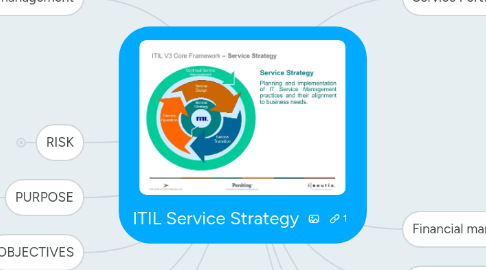
1. what services should we offer
1.1. evaluating services
1.1.1. will the service provide value?
1.1.1.1. "you can ensure services are valuable by employing the concepts of Utility and Warranty"
1.1.2. Are we capable of delivering the services?
1.1.2.1. resources and capabilities
1.1.2.1.1. these are types of assets
2. what business are we in?
3. Service Automation
3.1. Productivity Tools
3.2. Analytical Modeling
3.3. Simulation Tools
3.4. Visualization Tools
4. RISK
4.1. inevitable
4.2. probability of a threat
4.2.1. uncertain outcome
4.3. measure by
4.3.1. probability x vulnerability x impact
5. Service Portfolio Management
5.1. is
5.1.1. service catalog
5.1.1.1. live
5.1.1.2. available for deployment
5.1.1.3. contains
5.1.1.3.1. contacts
5.1.1.3.2. escalation points
5.1.1.3.3. price points
5.1.1.3.4. DETAILS OF ALL OPERATIONAL SERVICES
5.1.1.3.5. deliverable info
5.1.1.3.6. ordering & request processes
5.1.2. pipeline
5.1.2.1. proposed, but have been accepted
5.1.2.2. will it provide value?
5.1.2.3. are we capable of delivering?
5.1.2.3.1. resources
5.1.2.3.2. capability
5.1.2.4. Utility
5.1.2.4.1. what it does
5.1.2.4.2. fit for purpose
5.1.2.4.3. OR
5.1.2.4.4. "is the functionality offered by a product or service to meet a particular need"
5.1.2.5. Warranty
5.1.2.5.1. how its delivered
5.1.2.5.2. fit for use
5.1.2.5.3. AND
5.1.2.5.4. Customers are assured of certain levels of availability, capacity, continuity and security
5.1.2.5.5. NOT
5.1.2.5.6. "is an assurance that a product or service will meet its agreed requirements"
5.1.2.6. assets
5.1.2.6.1. Capability
5.1.2.6.2. service
5.1.3. retired services
5.1.3.1. capture resources resources and dispose or redeploy
5.1.3.1.1. q
5.1.3.2. how long in retired
5.1.3.2.1. up to you
5.1.4. "commitments and investments made by a service provider across all customers and market spaces"
5.2. service
5.2.1. comprised of
5.2.1.1. customer asset
5.2.1.1.1. tv
5.2.1.2. service asset
5.2.1.2.1. satellite service
5.2.2. provider
5.2.2.1. suppliers services to internal or external customers
5.2.2.2. 3 types
5.2.2.2.1. type one - internal embedded within a business unit
5.2.2.2.2. type two - shared services business unit e.g. (IT)
5.2.2.2.3. service packaging
5.2.2.2.4. type three - external service provider.
5.2.3. supplier is always 3rd party
5.2.4. Patterns of business activity
5.2.4.1. volumes of transactions
5.2.4.2. source of demand
5.2.4.3. requirements of security
5.2.4.4. specific resources
5.2.4.5. everytime BA performed it generates demand for services
5.2.4.6. PBA "represent the dynamics of the business and include interactions with customers, suppliers, partners and other stakeholders"
5.2.4.7. services often support business activities
5.2.4.7.1. BA achieve business outcomes
5.2.4.8. PBA profiles
5.2.4.8.1. classification
5.2.4.8.2. attributes
5.2.4.8.3. requirements
5.2.4.8.4. service asset requirements
5.3. entry and exit only with approved funding and financial plan.
5.4. right mix to ensure financial viability
5.5. management
5.5.1. analyse risk and return
5.5.2. maintain portfolio
5.5.3. control which services are offered
5.5.4. evaluate services
5.5.5. track investments
5.5.6. determine viability
6. Financial management
6.1. accounting
6.1.1. what it costs to offer each of our services
6.1.2. variance between budgeted cost and actual cost
6.2. budgeting
6.2.1. predicting and controlling way money is spent
6.2.2. monthly & annual cycles
6.3. charging
6.3.1. requiring payment for IT services
6.3.2. not mandatory
6.3.2.1. may be seen as a cost centre
6.3.3. notional expenses
6.4. objectives
6.4.1. framework
6.4.2. evaluate fin impacts
6.4.3. protect service and customer assets
6.4.3.1. SACM
6.4.3.1.1. service asset and config mgt
6.5. scope
7. Business relationship management
7.1. understand current and future needs of customer
7.2. mge customer expectations
7.3. measured CSAT
7.4. objectives
7.4.1. CSAT
7.4.2. mediate
7.4.3. hjelp customer maximise value of their contract
7.5. scope
7.5.1. total relationship
8. PURPOSE
8.1. "to define the perspective, position, plan and patterns that a serivce providers needs to be able to execute to meet an organisation's business outcomes."
9. OBJECTIVES
9.1. define services and customers who use them
9.2. define how value is created and delivered
9.3. identify opportunities to provide services
9.4. service provision model
9.4.1. how services will be
9.4.2. delivered
9.4.3. funded and
9.4.4. for whom and why
9.5. how service assets are used to deliver services & how to optimse
9.6. means to understand organisational capability to deliver the strategy
9.7. processes that define the strategy
9.8. services that will achieve that strategy
9.9. investment etc
10. SCOPE
10.1. Define the strategy which a service provider will use to meets a customer's business outcomes
10.2. how to manage those services
11. VALUE
11.1. activities to outcomes
11.2. what types & levels of service will deliver value
11.3. respond to changes
11.4. create & maintain service portfolio
11.5. support communication
11.6. help efficient organisation
12. value
12.1. how do we create value?
12.1.1. Business Outcomes
12.1.2. Perceptions
12.1.2.1. view of you
12.1.2.2. view of service you provide
12.1.3. Customer Preferences
12.1.3.1. only certain kind of vendor
12.2. what is value?
12.2.1. Defined by customer
12.2.2. Affordable mix of features
12.2.3. Achievement of objectives
12.2.4. changes over time and circumstances
12.3. measure value
12.3.1. what serivces did IT provide
12.3.1.1. did they link it to customer outcomes
12.3.2. what did the services achieve?
12.3.3. How much did the services cost
12.4. Creating value chain
12.4.1. is
12.4.1.1. sequence of processes that create a product or service
12.4.1.2. each step builds on previous
12.4.1.3. true value only calc after value is realised
12.4.1.4. value realised must be greater than money spent
12.4.2. means
12.4.2.1. all activities must relate to value realisation
12.4.2.2. otherwise money-spending org
12.4.2.3. else only demo by CUTTING COSTS = vicious cycle
12.5. Economic value
12.5.1. baseline
12.5.2. positive difference
12.5.2.1. additional benefits
12.5.2.2. warranty utility
12.5.3. negative differnce
12.5.3.1. quality issues
12.5.3.2. hidden costs
12.5.4. net difference
12.5.4.1. how much better or worse than reference value
12.5.5. "the total value that the customer perceives the service to deliver. It includes the reference value plus (or minus) the net difference of the service they receive, and is measured by the customer in the ability to meet their desired outcomes"
